Saturday, 31 August 2013

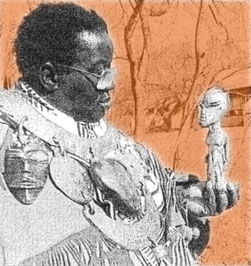
Fig. 1: Vusamazulu Credo Mutwa waring his sacred relics and holding an ancient statue

Fig. 2: My meeting with Credo Mutwa on a humble farm between Pretoria and Johannesburg in April 2005. (Photo: Müller / Berkovits)
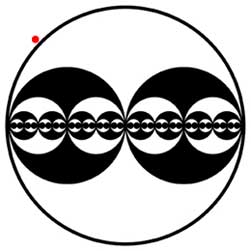
Fig. 3: Small outside cirlces as the one marked red in this diagram (Cliffords Hill, Wilts. UK, 2001) are called "grapeshot" circles. According to Credo Mutwa they mark the spot from where to view, interpret the designs as well as the spot to respond to the intelligence behind. (Diagram: A. Müller)
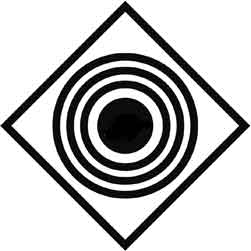
Fig. 4: A basic graphical reconstruction of the 1879 huge crop circle formation in Zululand, but Without the cetral standing design. The central circle was said to have shown something that was seen as a depiction of the later used canon guns. (Diagram: A. Müller - based on description)
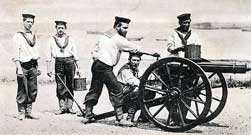 aa
aa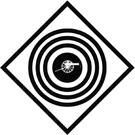
Fig. 5: The true central design was obviously open for speculation. However, the photo on the left shows a Royal Navy Gatling Gun Team in 1865. This is the kind of canon-gun also used during the Battle of Ulundi in 1879. (Copyright by National Archives and Record Administration). Right: An artistic interpretation combines the described crop circle formation's basic design with a Gatling gin symbol. (Diagram: A. Müller)
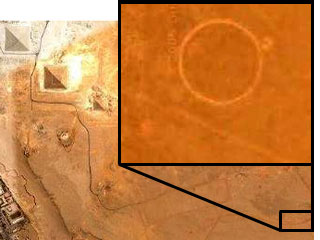
Fig. 9: A "ring with an outer satellite circle" with a diameter of about 50 meters can be seen on GoogleEarth satellite images of the famous Giza pyramids near Cairo. (Satellite immage by GoogleEarth / DigitalGlobe)


Fig. 11: Triangular formation seen by Credo Mutwa in 1958 in the Natal region. Left: Credo Mutwa's orginal Sketch. (Diagram: A. Müller / Sketch: Credo Mutwa)
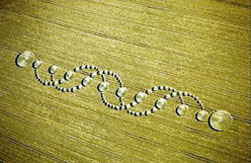
Fig. 14: The so-called „DNA“ discovered on June 7, 1996 in the East Field, Wiltshire, United Kingdom. (Photo: Steve Alexander)

„The world in which we live is more miraculous than we know. There are things which go on in our world about which we know nothing.“ Vusamazulu Credo Mutwa
By Andreas Muller
Prologue
Prologue
In late 2002 I read the book „Secrets in the Fields“ by crop circle researcher Freddy Silva. On page 303 the author writes:
„If contact with non human life continues to follow the U.S. military’s example of researching UFOs – shoot them down and analyze them – then it’s no wonder contact needs to be made in more subtle ways with people who appear to have every inclination of behaving like barbarians. Yet compare this attitude with that of „pagans“ in South Africa in response to crop circles: „Whenever a circle appeared in the fields, the people rushed to erect a fence of poles around the circle. They would dance and perform other sacred rituals honouring the Star Gods and the Earth Mother. All the kings and chiefs awaited the arrival of these circles. Their appearance would be cause for celebrations that lasted several days. The celebrations were accompanied by prayers to the gods to watch over the people and talk to them through the sacred sites.“ (MUTWA 1996, 23 / SILVA 2002, 303)
As the bibliographical reference Silva gives:
Mutwa, Credo. 1996. Isilwane: The Animal. Cape Town, S. Africa: Struick.
To be honest, I’d never heard of this book or its author before. I soon learnt more about this astonishing man, when doing an online search for his name.
Vusamazulu Credo Mutwa
„If contact with non human life continues to follow the U.S. military’s example of researching UFOs – shoot them down and analyze them – then it’s no wonder contact needs to be made in more subtle ways with people who appear to have every inclination of behaving like barbarians. Yet compare this attitude with that of „pagans“ in South Africa in response to crop circles: „Whenever a circle appeared in the fields, the people rushed to erect a fence of poles around the circle. They would dance and perform other sacred rituals honouring the Star Gods and the Earth Mother. All the kings and chiefs awaited the arrival of these circles. Their appearance would be cause for celebrations that lasted several days. The celebrations were accompanied by prayers to the gods to watch over the people and talk to them through the sacred sites.“ (MUTWA 1996, 23 / SILVA 2002, 303)
As the bibliographical reference Silva gives:
Mutwa, Credo. 1996. Isilwane: The Animal. Cape Town, S. Africa: Struick.
To be honest, I’d never heard of this book or its author before. I soon learnt more about this astonishing man, when doing an online search for his name.
Vusamazulu Credo Mutwa
The following is an abstract of his biography taken from Stephen Larsen’s editorial notes of Credo Mutwa’s book „Zulu Shaman“ (originally published under the title „Song of the Stars“ in 1996):
Vusamazulu Credo Mutwa was born in the Natal area of South Africa on July 21, 1921. His very name is a composite of his cultures of origin. „Vusamazulu“ is a Zulu honorific, meaning „Awakener of the Zulus“ and came through his initiation as a Sangoma (Traditional Healer, Shaman). But the name „Credo“ was given to him by his father, a Christian. It is from the Latin „I believe“. „Mutwa“ is Zulu for „little Bushman“ - „Vusamazulu Credo Mutwa“ then may be rendered to „Great Awakener, I Believe (in) Little Bushman“.
Credo was baptized into the Roman Catholic Church his father having held the position of „catechism instructor“. His mother Numabunu, however, was the daughter of the shaman-warrior Ziko Shezi, who had survived the awful battle of Ulundi, which ended the Zulu-Wars. Shezi was a Samgoma, and custodian of Zulu relics. The split in religion was to prove decisive for his parents’ relationship, and they never formally married, separating soon after Mutwa was born.
Fortunately, Mutwa received early training from his grandfather Ziko Shezi, and memorably the child would carry his grandfather’s medicine bags, full of sacred objects, to various ceremonies.
Credo Mutwa from an early time showed a proclivity for art, especially sculpture. (...)
In 1928 his father entered the picture again and obtained custody of the child over the objections of his mother. The young lad was obliged to go to the Transvaal with his father, stepmother and their three children. The family moved around to several different farms, and finally settled near Johannesburg (...).
Credo was educated in mission schools, taught in English about Western history and civilisation, and confirmed as a Christian in the process. His goal in those years was to become a schoolteacher, and hence he studied his lessons very well. (...)
In 1943 there began a time of sickness and disorientation for the young man. He was afflicted with dreams and visions, and a strange malaise would often come over him. He was experiencing the sickness that often comes to future Sangomas, initiating their call.
Now there are several kinds of traditional healers among the Zulu. An „Inyanga“ may inherit the profession from relatives. But a „Sangoma“ must receive a „call“ from the spirits, which seemed to be happening to the young man. At the urging of his mother and grandfather, Mutwa would undergo purification ceremonies, renounce formal Christianity, and begin to prepare himself to receive the training of the Sangoma. (...)
Vusamazulu Credo Mutwa was born in the Natal area of South Africa on July 21, 1921. His very name is a composite of his cultures of origin. „Vusamazulu“ is a Zulu honorific, meaning „Awakener of the Zulus“ and came through his initiation as a Sangoma (Traditional Healer, Shaman). But the name „Credo“ was given to him by his father, a Christian. It is from the Latin „I believe“. „Mutwa“ is Zulu for „little Bushman“ - „Vusamazulu Credo Mutwa“ then may be rendered to „Great Awakener, I Believe (in) Little Bushman“.
Credo was baptized into the Roman Catholic Church his father having held the position of „catechism instructor“. His mother Numabunu, however, was the daughter of the shaman-warrior Ziko Shezi, who had survived the awful battle of Ulundi, which ended the Zulu-Wars. Shezi was a Samgoma, and custodian of Zulu relics. The split in religion was to prove decisive for his parents’ relationship, and they never formally married, separating soon after Mutwa was born.
Fortunately, Mutwa received early training from his grandfather Ziko Shezi, and memorably the child would carry his grandfather’s medicine bags, full of sacred objects, to various ceremonies.
Credo Mutwa from an early time showed a proclivity for art, especially sculpture. (...)
In 1928 his father entered the picture again and obtained custody of the child over the objections of his mother. The young lad was obliged to go to the Transvaal with his father, stepmother and their three children. The family moved around to several different farms, and finally settled near Johannesburg (...).
Credo was educated in mission schools, taught in English about Western history and civilisation, and confirmed as a Christian in the process. His goal in those years was to become a schoolteacher, and hence he studied his lessons very well. (...)
In 1943 there began a time of sickness and disorientation for the young man. He was afflicted with dreams and visions, and a strange malaise would often come over him. He was experiencing the sickness that often comes to future Sangomas, initiating their call.
Now there are several kinds of traditional healers among the Zulu. An „Inyanga“ may inherit the profession from relatives. But a „Sangoma“ must receive a „call“ from the spirits, which seemed to be happening to the young man. At the urging of his mother and grandfather, Mutwa would undergo purification ceremonies, renounce formal Christianity, and begin to prepare himself to receive the training of the Sangoma. (...)

Fig. 1: Vusamazulu Credo Mutwa waring his sacred relics and holding an ancient statue
Credo Mutwa was to prove to be a very successful Sangoma, and eventually was elevated to the rank of „High Sanusi“, like the Indian „Sannyasin“, a holy man who has taken vows. In his way he came to be the leader of well over 500 other traditional healers.
„When I was made into a Sanusi, I took a vow never to reveal my knowledge, never to tell people about my profession or about the sacred artefacts (...) that I am entrusted with. But I feel that this vow is a hindrance, and some years ago I decided to break it. The result of this has been that my people have ostracized me and many people have bitterly blamed me for what I had done.“
Credo Mutwa very much believes in the value of tradition, but also affirms that we live in changing times. The traditions are to be kept, but their influence is to be made open to a larger audience than the dwindling faithful among the Zulu people.
The keepers of traditional stories are called „Guardians of the Umlando (tribal history), a different but overlapping role with that of the Sangoma. This role also Credo has embraced. To become this kind of traditional storyteller requires and aptitude for precise memorization and also the dramatic and artistic recitation of the stories. (...) (LARSEN/MUTWA 1996/2003, xiii)
Izishoze Zamatongo
„When I was made into a Sanusi, I took a vow never to reveal my knowledge, never to tell people about my profession or about the sacred artefacts (...) that I am entrusted with. But I feel that this vow is a hindrance, and some years ago I decided to break it. The result of this has been that my people have ostracized me and many people have bitterly blamed me for what I had done.“
Credo Mutwa very much believes in the value of tradition, but also affirms that we live in changing times. The traditions are to be kept, but their influence is to be made open to a larger audience than the dwindling faithful among the Zulu people.
The keepers of traditional stories are called „Guardians of the Umlando (tribal history), a different but overlapping role with that of the Sangoma. This role also Credo has embraced. To become this kind of traditional storyteller requires and aptitude for precise memorization and also the dramatic and artistic recitation of the stories. (...) (LARSEN/MUTWA 1996/2003, xiii)
Izishoze Zamatongo
In the foreword of the aforementioned book „Isilwane The Animal - Tales and Fables of Africa” Mutwa recounts the following:
(...) At harvest time, we left some of our corn standing so that passing birds could share in the bounty of our fields and, by sharing, bless us and ensure us of plenty of food. Sometimes large fields of corn and millet were planted. These were sacred to the goddess and were offered to the vast armies of birds to eat. No human being could enter the sacred cornfield.
The sacred fields were ploughed far from the ordinary millet, maize and corn, as they were left unfenced. Over centuries, people had discovered that the star gods sometimes communicated with human beings through these sacred fields. Time and again, strange circular depressions were seen in the centre of these fields. These depressions were called „Izishoze Zamatongo“, the great circles of the gods.
These circles were an amazing sight to see. The gods never cut the stalks of corn or millet when they form these depressions. It appears as though a great circular, disk-shaped force has descended on the field. It pressed the corn firmly into the ground, without breaking the stalks or damaging the plants. Then the force appears to spin, resulting in the strange spiral appearance of the fallen stalks. Words cannot describe such a phenomenon, which I have seen more than thirty times in the course of my life as a traditional healer. Whenever a circle appeared in the fields, the people rushed to erect a fence of poles around the circle. They would dance and perform other sacred rituals honouring the star gods and the Earth Mother.
All the kings and chiefs awaited the arrival of these circles. The appearance would be cause for celebrations that lasted several days. These celebrations were accompanied by prayers to the gods to watch over the people and to talk to them through the sacred circles.(...) (MUTWA 1996, 23)
When I read this I was struck by the way this description matched what we call the „Crop Circles“ and I wanted to learn more about this phenomenon on the African continent, currently unknown to Western crop circle research.
The Conversation
(...) At harvest time, we left some of our corn standing so that passing birds could share in the bounty of our fields and, by sharing, bless us and ensure us of plenty of food. Sometimes large fields of corn and millet were planted. These were sacred to the goddess and were offered to the vast armies of birds to eat. No human being could enter the sacred cornfield.
The sacred fields were ploughed far from the ordinary millet, maize and corn, as they were left unfenced. Over centuries, people had discovered that the star gods sometimes communicated with human beings through these sacred fields. Time and again, strange circular depressions were seen in the centre of these fields. These depressions were called „Izishoze Zamatongo“, the great circles of the gods.
These circles were an amazing sight to see. The gods never cut the stalks of corn or millet when they form these depressions. It appears as though a great circular, disk-shaped force has descended on the field. It pressed the corn firmly into the ground, without breaking the stalks or damaging the plants. Then the force appears to spin, resulting in the strange spiral appearance of the fallen stalks. Words cannot describe such a phenomenon, which I have seen more than thirty times in the course of my life as a traditional healer. Whenever a circle appeared in the fields, the people rushed to erect a fence of poles around the circle. They would dance and perform other sacred rituals honouring the star gods and the Earth Mother.
All the kings and chiefs awaited the arrival of these circles. The appearance would be cause for celebrations that lasted several days. These celebrations were accompanied by prayers to the gods to watch over the people and to talk to them through the sacred circles.(...) (MUTWA 1996, 23)
When I read this I was struck by the way this description matched what we call the „Crop Circles“ and I wanted to learn more about this phenomenon on the African continent, currently unknown to Western crop circle research.
The Conversation
It took me quite a long time to gain access to this holy man but finally in 2005 he invited me to visit him on the farm where he lives, in the hills between Pretoria and Johannesburg.

Fig. 2: My meeting with Credo Mutwa on a humble farm between Pretoria and Johannesburg in April 2005. (Photo: Müller / Berkovits)
I met Credo Mutwa in April of the same year and was astonished to find a man of his wisdom and high ranking living such a humble life; his simple dwellings incomparable to the palaces his differnt religious equivalents reside in worldwide. After a short introduction and viewing pictures of European crop circles that I brought with me, we started our conversation and I learnt my first lesson: I was prepared to conduct the interview in a traditional Western manner with a numbered list of questions. However, when confronted by a „Guardian of the Umlando“ like Credo Mutwa I soon realized that things would not unfold in the usual manner. When a man like him starts to talk to you about his folklore and traditions, there seems to be no beginning and no full stop – everything seems a single tale, enriched here and there with parables, references and comparisons to related stories. I have to admit, it was a good lesson to learn.
The following is a compilation of Credo Mutwa’s answers, regarding his knowledge about the crop circles in Africa. At some points I have taken the chance to add some notes that compare Credo Mutwa’s information to the crop circle phenomenon, at least as far as we currently understand it in the west.
General Information
The following is a compilation of Credo Mutwa’s answers, regarding his knowledge about the crop circles in Africa. At some points I have taken the chance to add some notes that compare Credo Mutwa’s information to the crop circle phenomenon, at least as far as we currently understand it in the west.
General Information
„What you call ‘Crop Circles’ is the same that what the Zulu call „Izishoze Zamatongo“ and which means the designs or the writings of the Gods. We have known about them for more than 4000 years.“
Author’s note: In other parts of the world, recent research has also shown that the crop circle phenomenon is not a contemporary enigma but has probably always been with us. The oldest record of a European crop circle dates back to the year 1590 and was found documented in a French witch-trial case. (MÜLLER / ANDERHUB 2005, 41). Much older reports of discoveries of flattened circular areas of crops and grass have also been found in European and North American folklore-tales, legends and myths (MÜLLER 2001, 10).
„I have seen these things hundreds of times before. (Author’s comment: The alert reader will note that we have a discrepancy here in the numbers given between what is said in the aforementioned book „Isilwane. The Animal“ and in our conversation: In the book Credo Mutwa mentions that he had seen crop circles himself „more than thirty times“ and now he talks about a „hundreds of times“. This discrepancy can be explained in several ways. On the one hand the book was published in 1996, some nine years prior to our conversation and on the other – due to the editing process - there is a difference between a written book by Mr. Mutwa and a vital conversation with him.) These things are very funny... they don’t like the miellies (maize / American corn). They appear on our millet, they appear on our sokka, these are two different kinds of crop. The crop circles like to appear on millet and all sorts of small grain plants. The Gods choose their kind of grain. They don’t like the corn (maize) – Why? – Because with that grain you cannot make a good crop circle on it like you can on millet. So they choose these grains that are native to the country in which they appear. Corn is not native to Africa.“
Author’s note: This might deliver a clue to the question why there have been indeed so very few crop circles in corn/maize in England, Europe and other parts of the world, while a great part of the phenomenon in American countries like USA, Canada, Mexico etc. used just those fields for its canvas.
„If the land is too flat you cannot see what the Gods have been telling us unless you go to a nearby mountain (to have a good vantage point from which to view the design). They don’t destroy the plants. They bend them so that after a time the plant can recover – they don’t want to destroy. This is why those men who say that these are all forgeries are wrong. How can somebody fake something like this without damaging the plants? You can’t! It also takes those who try it many, many hours to do so. This is not the way the Gods make Izishoze.“
What is the Meaning?
Author’s note: In other parts of the world, recent research has also shown that the crop circle phenomenon is not a contemporary enigma but has probably always been with us. The oldest record of a European crop circle dates back to the year 1590 and was found documented in a French witch-trial case. (MÜLLER / ANDERHUB 2005, 41). Much older reports of discoveries of flattened circular areas of crops and grass have also been found in European and North American folklore-tales, legends and myths (MÜLLER 2001, 10).
„I have seen these things hundreds of times before. (Author’s comment: The alert reader will note that we have a discrepancy here in the numbers given between what is said in the aforementioned book „Isilwane. The Animal“ and in our conversation: In the book Credo Mutwa mentions that he had seen crop circles himself „more than thirty times“ and now he talks about a „hundreds of times“. This discrepancy can be explained in several ways. On the one hand the book was published in 1996, some nine years prior to our conversation and on the other – due to the editing process - there is a difference between a written book by Mr. Mutwa and a vital conversation with him.) These things are very funny... they don’t like the miellies (maize / American corn). They appear on our millet, they appear on our sokka, these are two different kinds of crop. The crop circles like to appear on millet and all sorts of small grain plants. The Gods choose their kind of grain. They don’t like the corn (maize) – Why? – Because with that grain you cannot make a good crop circle on it like you can on millet. So they choose these grains that are native to the country in which they appear. Corn is not native to Africa.“
Author’s note: This might deliver a clue to the question why there have been indeed so very few crop circles in corn/maize in England, Europe and other parts of the world, while a great part of the phenomenon in American countries like USA, Canada, Mexico etc. used just those fields for its canvas.
„If the land is too flat you cannot see what the Gods have been telling us unless you go to a nearby mountain (to have a good vantage point from which to view the design). They don’t destroy the plants. They bend them so that after a time the plant can recover – they don’t want to destroy. This is why those men who say that these are all forgeries are wrong. How can somebody fake something like this without damaging the plants? You can’t! It also takes those who try it many, many hours to do so. This is not the way the Gods make Izishoze.“
What is the Meaning?
„These things they happen to pass important messages to the people through the crops. The Izishoze happen to appear many times when our people are planting the African crop that they called mabele - or sorghum in English. The Gods used to flatten the plants and not to break them. So that after a time when the people have read the message, the plants would stand up again and grow.“
„I have always wanted to have a farm of my own. To watch out for the writings of the Gods because this is intelligence very, very big and whatever these powerful beings are telling us even means that our minds are to stupid to understand. Our modern minds have been corrupted by western civilisation that is refusing to believe that things like the crop circles could be real and important. This is why we do not understand the simple messages anymore.“
„The crop circles also tell us about the situation of the Sun. But why - you may ask – is the Earth Mind telling us about the Sun? The crop circle phenomenon talks of a time of great activity of the sun. But why? Why does this great intelligence, this Mother Spirit, why does it tell us about this thing? When there is trouble in the sun – then what happens to the human beings down here? When there is trouble in the sun there will be also trouble down on earth. And this is why the crop circles are appearing. They even tell us things that will happen in the future. They can also be warnings. For example if there is going to be a war – the crop circles tell us.“
African Crop Circle Traditions
„I have always wanted to have a farm of my own. To watch out for the writings of the Gods because this is intelligence very, very big and whatever these powerful beings are telling us even means that our minds are to stupid to understand. Our modern minds have been corrupted by western civilisation that is refusing to believe that things like the crop circles could be real and important. This is why we do not understand the simple messages anymore.“
„The crop circles also tell us about the situation of the Sun. But why - you may ask – is the Earth Mind telling us about the Sun? The crop circle phenomenon talks of a time of great activity of the sun. But why? Why does this great intelligence, this Mother Spirit, why does it tell us about this thing? When there is trouble in the sun – then what happens to the human beings down here? When there is trouble in the sun there will be also trouble down on earth. And this is why the crop circles are appearing. They even tell us things that will happen in the future. They can also be warnings. For example if there is going to be a war – the crop circles tell us.“
African Crop Circle Traditions
„In the old days, when the Gods put crop circles in our fields the people used to run quickly to take sticks and stones all around the design to mark it out. We wanted that the Gods should say again what they are telling us. This is therefore so that the crop circle does not die and that the Gods will then again respond with another crop circle nearby. This is why sometimes there will be a new crop circle next to an old one.
„This is how the African stone circle monuments came into existence. And this happened all over the worldwide as with Stonehenge, Avebury and the like. The Stonehenge monument you can see today, there used to be a crop circle there. This would have been regarded as a very holy thing so the ancient people marked it with earth, stones and wooden sticks. They are a sort of saying ‚Thank you’ to the intelligence that is behind. They were not built just for decoration. The ancient chiefs, kings and holy people were not fools. They were in tune with the Great Spirits of the earth. They were in tune with the mysteries of the world. They knew more that we give them credit for but they kept the knowledge away from us. Deciphering it in their temples. Therefore you can see so many similarities between the crop circles and ancient sacred art. This is no coincidence.“
Author’s note: The hypothesis that ancient stone circles and henges mark the locations of ancient crop circles, regarded by the people of that time as a scared sign and therefore marked out as a future place of ceremonies, has also been considered by Western crop circle researchers, most notably by research pioneer Dr. Terence Meaden in his book „The Stonehenge Solution“ (MEADEN 1992, 62).
„Here (pointing to a so-called "grapeshot" circle on a picture of a formation) the Gods have given us a sign: This is where they have signed off like a signature. They are saying: Here is the message, over and out. We have to acknowledge the design from here. This is where we have to respond.“
„This is how the African stone circle monuments came into existence. And this happened all over the worldwide as with Stonehenge, Avebury and the like. The Stonehenge monument you can see today, there used to be a crop circle there. This would have been regarded as a very holy thing so the ancient people marked it with earth, stones and wooden sticks. They are a sort of saying ‚Thank you’ to the intelligence that is behind. They were not built just for decoration. The ancient chiefs, kings and holy people were not fools. They were in tune with the Great Spirits of the earth. They were in tune with the mysteries of the world. They knew more that we give them credit for but they kept the knowledge away from us. Deciphering it in their temples. Therefore you can see so many similarities between the crop circles and ancient sacred art. This is no coincidence.“
Author’s note: The hypothesis that ancient stone circles and henges mark the locations of ancient crop circles, regarded by the people of that time as a scared sign and therefore marked out as a future place of ceremonies, has also been considered by Western crop circle researchers, most notably by research pioneer Dr. Terence Meaden in his book „The Stonehenge Solution“ (MEADEN 1992, 62).
„Here (pointing to a so-called "grapeshot" circle on a picture of a formation) the Gods have given us a sign: This is where they have signed off like a signature. They are saying: Here is the message, over and out. We have to acknowledge the design from here. This is where we have to respond.“

Fig. 3: Small outside cirlces as the one marked red in this diagram (Cliffords Hill, Wilts. UK, 2001) are called "grapeshot" circles. According to Credo Mutwa they mark the spot from where to view, interpret the designs as well as the spot to respond to the intelligence behind. (Diagram: A. Müller)
„We have to measure the new formations from one to the other side. The bigger the formations, the more important the message and the closer the date...“
„This is one of the holy things. It is teaching us about the human mind. It also teaches us about the world-mind. We say the earth has got a brain and the brain passes knowledge to the people (through the sacred fields).“
„These crop circles are created by a power which is compassionate. The spirit who makes the crop circles guides human beings, it tells them important things that human beings are not aware of yet.“
Author’s note: Here (as well as with the above discussed idea that the „natural message“ of the circles is too simple for our complicate minds) Credo Mutwa agrees with other traditional and native representatives. Also the Aborigines people of Australia share this very same view. (DOUK 2000)
„Long time ago, when all my sacred items were given to me, I was told that we must always look out for those things, always because this is what the God Spirit - which is the mind of the earth - is telling us about important things about the universe...about what is going to happen.“
„These are things that we Sangomas are called to investigate. I have always wanted to have a farm of my own. To watch out for the writings of the Gods (...)“
„I remember that my grandmother used to say that we must show respect for the crop circles as well as we have to show our respect to the standing stones.“
„The signs do prophesize. They tell us about the future. This is why Sangomas must plant millet because this is the plant the Gods prefer to speak through.“
The Crop Circles in Africa
„This is one of the holy things. It is teaching us about the human mind. It also teaches us about the world-mind. We say the earth has got a brain and the brain passes knowledge to the people (through the sacred fields).“
„These crop circles are created by a power which is compassionate. The spirit who makes the crop circles guides human beings, it tells them important things that human beings are not aware of yet.“
Author’s note: Here (as well as with the above discussed idea that the „natural message“ of the circles is too simple for our complicate minds) Credo Mutwa agrees with other traditional and native representatives. Also the Aborigines people of Australia share this very same view. (DOUK 2000)
„Long time ago, when all my sacred items were given to me, I was told that we must always look out for those things, always because this is what the God Spirit - which is the mind of the earth - is telling us about important things about the universe...about what is going to happen.“
„These are things that we Sangomas are called to investigate. I have always wanted to have a farm of my own. To watch out for the writings of the Gods (...)“
„I remember that my grandmother used to say that we must show respect for the crop circles as well as we have to show our respect to the standing stones.“
„The signs do prophesize. They tell us about the future. This is why Sangomas must plant millet because this is the plant the Gods prefer to speak through.“
The Crop Circles in Africa
„If there is going to be a war – the crop circles tell us. These things are warnings.
„Our crop circles in Africa are not only circles; they are just as complicated as the English ones, even more complex sometimes. Our biggest crop circle appeared in Zululand, it was made up of four of them inside a big square and in the centre was a picture, a picture of a gun, a picture of a gun canon. That was just before the terrible Battle of Ulundi in 1879 where the English used artillery pieces and Gatling guns (the first highly successful rapid-repeating firearms) on the Zulus for the very first time.“
„Our crop circles in Africa are not only circles; they are just as complicated as the English ones, even more complex sometimes. Our biggest crop circle appeared in Zululand, it was made up of four of them inside a big square and in the centre was a picture, a picture of a gun, a picture of a gun canon. That was just before the terrible Battle of Ulundi in 1879 where the English used artillery pieces and Gatling guns (the first highly successful rapid-repeating firearms) on the Zulus for the very first time.“

Fig. 4: A basic graphical reconstruction of the 1879 huge crop circle formation in Zululand, but Without the cetral standing design. The central circle was said to have shown something that was seen as a depiction of the later used canon guns. (Diagram: A. Müller - based on description)
 aa
aa
Fig. 5: The true central design was obviously open for speculation. However, the photo on the left shows a Royal Navy Gatling Gun Team in 1865. This is the kind of canon-gun also used during the Battle of Ulundi in 1879. (Copyright by National Archives and Record Administration). Right: An artistic interpretation combines the described crop circle formation's basic design with a Gatling gin symbol. (Diagram: A. Müller)
Author's note: Back home in Germany I was checking out the available sources
for information and data on the Battle of Ulundi. Whilst reading through the various documents I stumbled upon a detail that had not even been mentioned by Credo Mutwa: Apparently the British troops, consisting of some 17.000 men, marched to the battle in the form of a "hollow square and halted on a low hill about 3km west of Ondini" (www.zululand.kzn.org.za).The crop circle formation appeared to not only predict the weapon used but also the way the British troops were fighting on the top of the hill, firing Gatling guns from inside their protective hollow square of soldiers. Compare these features with the above shown diagram in Fig. 3 and 4.
for information and data on the Battle of Ulundi. Whilst reading through the various documents I stumbled upon a detail that had not even been mentioned by Credo Mutwa: Apparently the British troops, consisting of some 17.000 men, marched to the battle in the form of a "hollow square and halted on a low hill about 3km west of Ondini" (www.zululand.kzn.org.za).The crop circle formation appeared to not only predict the weapon used but also the way the British troops were fighting on the top of the hill, firing Gatling guns from inside their protective hollow square of soldiers. Compare these features with the above shown diagram in Fig. 3 and 4.
„They look similar to the English crop circles but sometimes also slightly different. In African crop circles you can sometimes see faces of animals with horns. There are sometimes four: one facing up, one down, one left and the fourth to the right.“
Author's note: It was kind of hard to understand what this formal description would indicate. Finally it seems unclear (at least to the author) if those "animal faces" were more of a direct pictorial character or made of geometrical elements, like described in the following figure:

Author's note: It was kind of hard to understand what this formal description would indicate. Finally it seems unclear (at least to the author) if those "animal faces" were more of a direct pictorial character or made of geometrical elements, like described in the following figure:

Fig. 6: Faces of horned animals - from a crop circle point of view this could mean different things: On the one side (l.) it could mean a truly pictorial picture of a horned animals face, like for example the face of a bull. On the other side (m.) such a bull's face can also be created in the way of a pictogram, using basic geometrical figures only. The diagram on the right side shows an artistic interpretation of what the above described formations with four of such animals faces looking in each direction might have looked like. (Diagrams by A. Müller)
„They like grains which are soft and another kind of crops where you see African crop circles is the ‚Monkey Nut’. This has gentle leaves, they are beautiful and there you can see very beautiful crop circles as well. In the Eastern Transvaal I saw such formations in Monkey Nuts (Peanuts - not to be confused with the Cashew- and Paranuts that also have this epithet).


Fig. 7: According to Credo Mutwa, formations like the ones we call „Pendulums“ a typical crop circle variation in England during the early 1990’s (here at Crawley Down, Hampshire, England 13/07/90), are also typical for crop circles in peanut plants as they appear in South Africa’s Eastern Transvaal region. (Diagram by A. Müller)
„But here in South Africa we can also see crop circles in the Sand. Near Cape Town there is a place called „Cradock“, a village, and a small town of white people. In Cradock there is no crop but even now you can see crop circles in the sand.“
„In the Kalahari in Botswana you will see crop circles in the sand. Here the sand is blown away but some of them stay for weeks so that you can still see them long after but not as beautiful as on the millet. Also in Johannesburg where the mines are we find very white sand. This sand is very poisoned – and here we used to see crop circles there – especially after rain...very big ones.“
"They also appear in the sand of the North African deserts, as for example in Egypt."
Author’s note: In fact German UFO-researcher Michael Hesemann reported the very first formation in sand in his book “The Cosmic Connection”. He reported of an observation of air passenger Mrs. Charlotte Wüsthoff of Düsseldorf: On November 11, 1992, she was flying with „Egypt Air“ from Cairo to the Dead Sea. When they were at the height of Port Safaga she looked down onto the desert and saw a mysterious design in the sand. A circle with a mirror-inverted „F“ appendage and a smaller ring around the shaft of the „F“ - a classical crop circle design (HESEMANN 1999). However, it is not known of what the strange design in the desert was made of. Was it carved or blown into the sand, was it painted or marked in any other way?
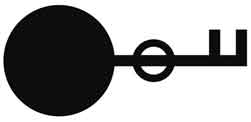
„In the Kalahari in Botswana you will see crop circles in the sand. Here the sand is blown away but some of them stay for weeks so that you can still see them long after but not as beautiful as on the millet. Also in Johannesburg where the mines are we find very white sand. This sand is very poisoned – and here we used to see crop circles there – especially after rain...very big ones.“
"They also appear in the sand of the North African deserts, as for example in Egypt."
Author’s note: In fact German UFO-researcher Michael Hesemann reported the very first formation in sand in his book “The Cosmic Connection”. He reported of an observation of air passenger Mrs. Charlotte Wüsthoff of Düsseldorf: On November 11, 1992, she was flying with „Egypt Air“ from Cairo to the Dead Sea. When they were at the height of Port Safaga she looked down onto the desert and saw a mysterious design in the sand. A circle with a mirror-inverted „F“ appendage and a smaller ring around the shaft of the „F“ - a classical crop circle design (HESEMANN 1999). However, it is not known of what the strange design in the desert was made of. Was it carved or blown into the sand, was it painted or marked in any other way?

Fig.8: Diagram of the described "Key" formation in the sand desert near Port Safaga, Egypt, 1992. (Diagram - based on description - by A. Müller)
A desert circle also seems to be visible on a satellite image presented by GoogleEarth. What crop circle researchers would call "a ring with a small satellite circle" can be seen in the sand just about 2 kilometers south of the famous Pyramids of Giza, outside of Cairo. However, so far there has been no ground inspection to this interesting feature in the sand and it is yet unknown when this satellite image was taken.

Fig. 9: A "ring with an outer satellite circle" with a diameter of about 50 meters can be seen on GoogleEarth satellite images of the famous Giza pyramids near Cairo. (Satellite immage by GoogleEarth / DigitalGlobe)
„We also find crop circles in the African grass or in the African savannah like in Kenya where there is a lot of good grass. If you want to see good crop circles – go to Kenya. In Massai Mara were the animals run plenty, plenty. You will see circles in the grass there – just as beautiful as these (pointing to the picture section of my book I brought to him a present).“
Author’s note: Kenyan crop circles seem to be confirmed also by other reports unconnected with Credo Mutwa. The mother of English crop circle researcher Allan Brown, for example, was raised on a farm near the capital Nairobi in the 1950’s. She recalls playing inside flattened circles in her father’s grain fields, a source of great annoyance to him.
„In the Southwest Africa, there the Owambo people of Namibia they plant millet, plenty of millet and there you see crop circles, really funny ones.“
„There is a thing which the Egyptians plant. It is called Bhali and there you see crop circles as well. But the people there they don’t like them.“
(A Mrs. Sharon, another visitor to Credo Mutwa at that time, who was also with us during parts our conversation) added: „If you fly from Johannesburg to Kruger National Park at this time of the year (April) when you look down the whole area of Lyndenburg you will see circles all over.“ Unfortunately the author was unable to tkae an aerial reconnassance flight over the described area.
Crop Circles Credo Mutwa Saw Himself
Author’s note: Kenyan crop circles seem to be confirmed also by other reports unconnected with Credo Mutwa. The mother of English crop circle researcher Allan Brown, for example, was raised on a farm near the capital Nairobi in the 1950’s. She recalls playing inside flattened circles in her father’s grain fields, a source of great annoyance to him.
„In the Southwest Africa, there the Owambo people of Namibia they plant millet, plenty of millet and there you see crop circles, really funny ones.“
„There is a thing which the Egyptians plant. It is called Bhali and there you see crop circles as well. But the people there they don’t like them.“
(A Mrs. Sharon, another visitor to Credo Mutwa at that time, who was also with us during parts our conversation) added: „If you fly from Johannesburg to Kruger National Park at this time of the year (April) when you look down the whole area of Lyndenburg you will see circles all over.“ Unfortunately the author was unable to tkae an aerial reconnassance flight over the described area.
Crop Circles Credo Mutwa Saw Himself
„I saw my very first crop circle in the Natal region in 1949. It was made of three circles inside each other placed in a field of potao plants“


Fig. 10: The first crop circle Credo Mutwa saw himself: A double-ringed circle in potato plants (r.) in the Natal region of South Africa, 1949. (Diagram: A. Müller, based on Credo Mutwa’s sketch)
„In 1958, again in Natal I saw a huge crop circle in the shape of two circles inside of a triangle“


Fig. 11: Triangular formation seen by Credo Mutwa in 1958 in the Natal region. Left: Credo Mutwa's orginal Sketch. (Diagram: A. Müller / Sketch: Credo Mutwa)
„On farms in Botswana there appeared a number of crop circles – many of them. I was called to go there and that was in 1959. I remember these were on sand and they were on the millet.“
„In the same year when I visited England and saw the large threefold Galaxy crop circle near Avebury (Triple Julia-Set at Windmill Hill, 1996) I also visited a beautiful one in the Eastern Transvaal. It showed a symmetrical pattern inside a ring made of two crescents and inside of each a five-pointed star.“
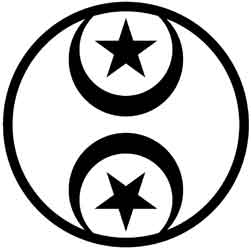
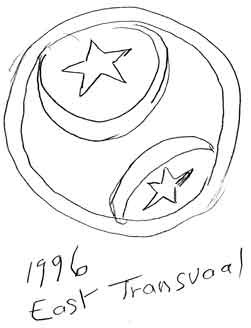
„In the same year when I visited England and saw the large threefold Galaxy crop circle near Avebury (Triple Julia-Set at Windmill Hill, 1996) I also visited a beautiful one in the Eastern Transvaal. It showed a symmetrical pattern inside a ring made of two crescents and inside of each a five-pointed star.“


Fig. 12: Complex geometrical crop circles similar to the patterns we know from England but investigated by Credo Mutwa in 1996 in the Eastern Transvaal. (Diagram: A. Müller, based on Credo Mutwa’s sketch)
Related Phenomena
„Also our people have observed the crop circles in the making. This is when they have seen the lights, balls of light spinning in the air and on the ground. But then the people moved away because they don’t want the Gods to get angry – they hide in their houses while the Gods are finishing making their messages. These light-phenomena also happen in other places of great holiness.“
Author’s note: Flying lights and things we would call UFOs are also known in the Zulu and ancient African Tradition. They are called „Abahambi Abawutayo“ and Credo Mutwa writes about them also in his book „Song of the Stars“:
„There are things that fly through the night, those you call UFOs, which we in Africa call ‚Abahambi Abavutayo’, ‚the fiery visitors’. Oh yes, Africa has had her own share of UFOs, and she has for many, many centuries, long before they were even heard of on other parts of the world, we, the people of Africa had contact with these things." (MUTWA 1996, 121)
Author’s note: Flying lights and things we would call UFOs are also known in the Zulu and ancient African Tradition. They are called „Abahambi Abawutayo“ and Credo Mutwa writes about them also in his book „Song of the Stars“:
„There are things that fly through the night, those you call UFOs, which we in Africa call ‚Abahambi Abavutayo’, ‚the fiery visitors’. Oh yes, Africa has had her own share of UFOs, and she has for many, many centuries, long before they were even heard of on other parts of the world, we, the people of Africa had contact with these things." (MUTWA 1996, 121)
Also similar observations are known to be connected with crop circles worldwide. So-called „Balls of Light“, „Orbs“ or „Luminosities“ were seen by many crop circle enthusiasts over the years. The most spectacular event include even the forming of crop circles as some sort of interaction with the light-phenomena – just as described by Credo Mutwa too.
„Try it one time if a crop circle is still new: Sit right in the centre of it and you will realize funny things. (If it is a genuine crop circle) you will feel as if your head will be pulled upwards and you will feel it to your heart by lying on the ground on your back you will see that your heart is beating strong against the breastbone. Try it.“
„Cameras do also fail inside African crop circles as well, just as I heard it happens in English crop circles ...if the crop circle is still fresh.“
Author’s note: Very similar things to the ones described above are also known from crop circles in other countries and continents.
„Funny enough ‚crop circles’ are not only made by crops. If you put a lot of cattle in your village and they are in a big place you will sometimes find animals forming strange circles and patterns as well.“
Author’s note: Without Credo Mutwa knowing, his strange tale of „cattle circles“ have indeed also been observed and documented in Europe. A satisfactory explanation is still awaited. (DAMERELL 2002)
Meanings of Specific Crop Circles - According to Credo Mutwa
„This formation is horrifying me. That (American) star and the pentagon forming a crop circle.... What on earth happened that day? Was it a war?
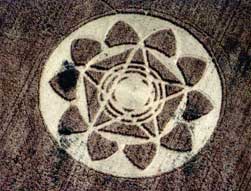
„Try it one time if a crop circle is still new: Sit right in the centre of it and you will realize funny things. (If it is a genuine crop circle) you will feel as if your head will be pulled upwards and you will feel it to your heart by lying on the ground on your back you will see that your heart is beating strong against the breastbone. Try it.“
„Cameras do also fail inside African crop circles as well, just as I heard it happens in English crop circles ...if the crop circle is still fresh.“
Author’s note: Very similar things to the ones described above are also known from crop circles in other countries and continents.
„Funny enough ‚crop circles’ are not only made by crops. If you put a lot of cattle in your village and they are in a big place you will sometimes find animals forming strange circles and patterns as well.“
Author’s note: Without Credo Mutwa knowing, his strange tale of „cattle circles“ have indeed also been observed and documented in Europe. A satisfactory explanation is still awaited. (DAMERELL 2002)
Meanings of Specific Crop Circles - According to Credo Mutwa
„This formation is horrifying me. That (American) star and the pentagon forming a crop circle.... What on earth happened that day? Was it a war?

Fig. 13: The „Bythorn Mandala“ was discovered on September 5, 1993 at Bythorn in Cambridgeshire, United Kingdom. (Photo: Lucy Pringle)
Author’s note: There has been no war directly connected to the date when the formation was formed. However, also Credo Mutwa wondered about the used symbolism: A five-pointed star - a pentagram - inscribed within a pentagon. Both symbols are today deeply connected to US-American warfare. The most direct martial intervention the USA was involved in at this time was the „Second Gulf War“. Appeal: If one of the readers can inform me about a more direct connection between a histrical (war)event and the discovery of the described cop circle formation (September 5, 1993), I would highly appreaciate if you could contact me!
„This is the string of the women because we use the exactly symbol to symbolize the menstruation of a woman ‚Indambo Ghamamba’ (correct spelling unclear) . When an African Woman is having trouble with menstruation she had to have woven such a string in skin and it is exactly the way this is made.“
„This is the string of the women because we use the exactly symbol to symbolize the menstruation of a woman ‚Indambo Ghamamba’ (correct spelling unclear) . When an African Woman is having trouble with menstruation she had to have woven such a string in skin and it is exactly the way this is made.“

Fig. 14: The so-called „DNA“ discovered on June 7, 1996 in the East Field, Wiltshire, United Kingdom. (Photo: Steve Alexander)
„To me this is an African stitched knot. It is also the so-called "Grass Basket" and this a game between chiefs and we call it ‚Murambarabathi’ (The Game of God) was only used by the chiefs and not by ordinary people. It is made of grass and I am very surprised! What is an African design doing in an English field?“


Fig. 15: „The Basket“ formation, discovered on August 6, 1999 at Bishops Cannings, Wiltshire, United Kingdom. (Photo: Ulrich Kox)
Credo Mutwa About Hoaxing and Hoaxers
„They (the Gods) don’t destroy the plants. They bend them so that after a time the plant can recover – they don’t want to destroy. This is why those men who say that these are forgeries are wrong. How can somebody fake some thing like this without damaging the plants? You can’t! It also takes those who try it many, many hours to do this...“
„They (the Gods) don’t destroy the plants. They bend them so that after a time the plant can recover – they don’t want to destroy. This is why those men who say that these are forgeries are wrong. How can somebody fake some thing like this without damaging the plants? You can’t! It also takes those who try it many, many hours to do this...“
Read more: Kornkreise

No comments:
Post a Comment